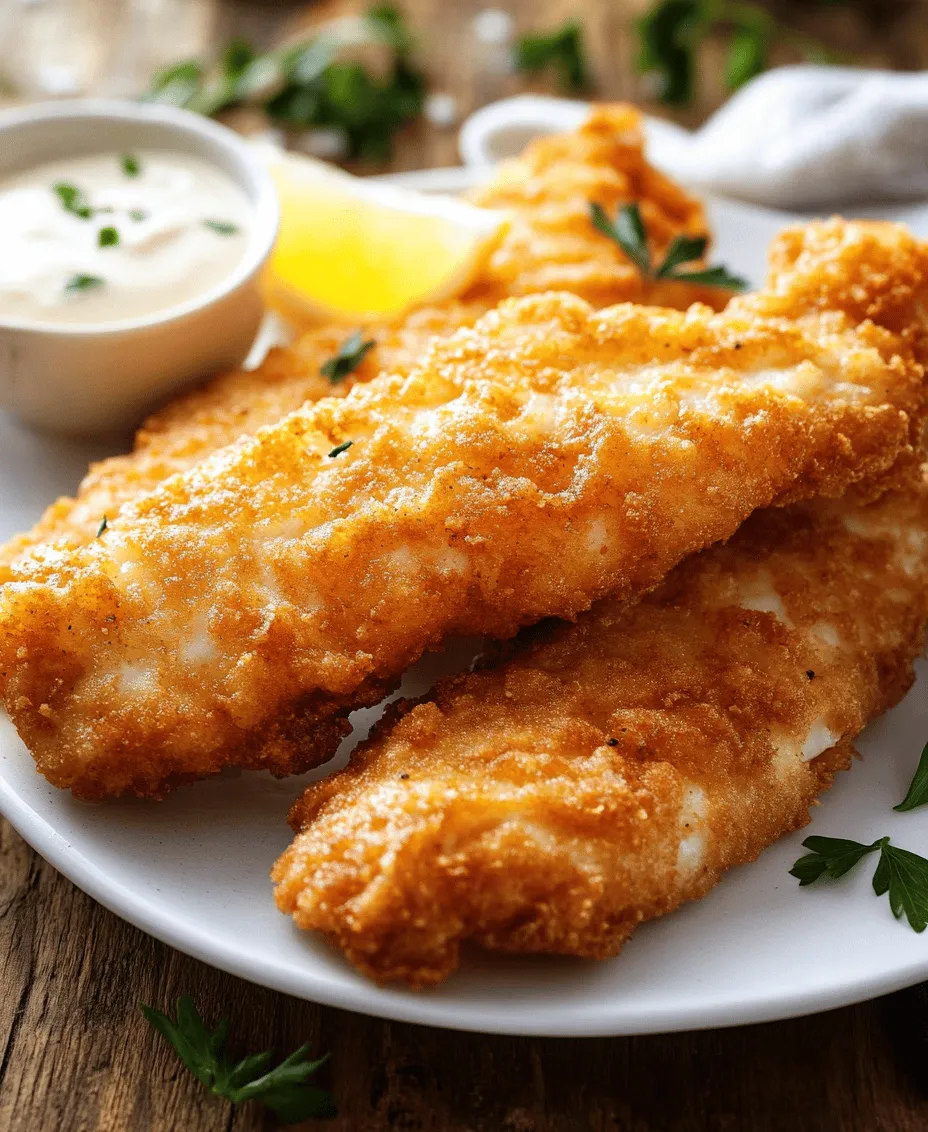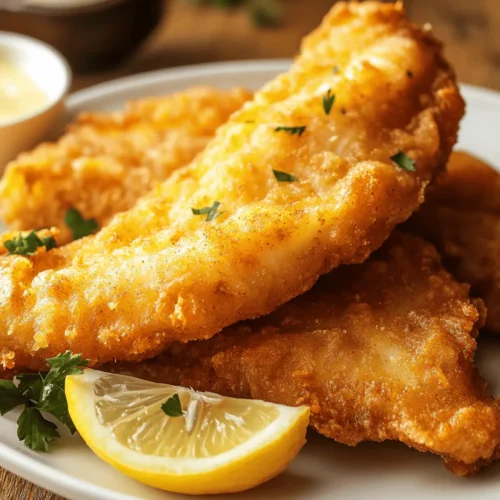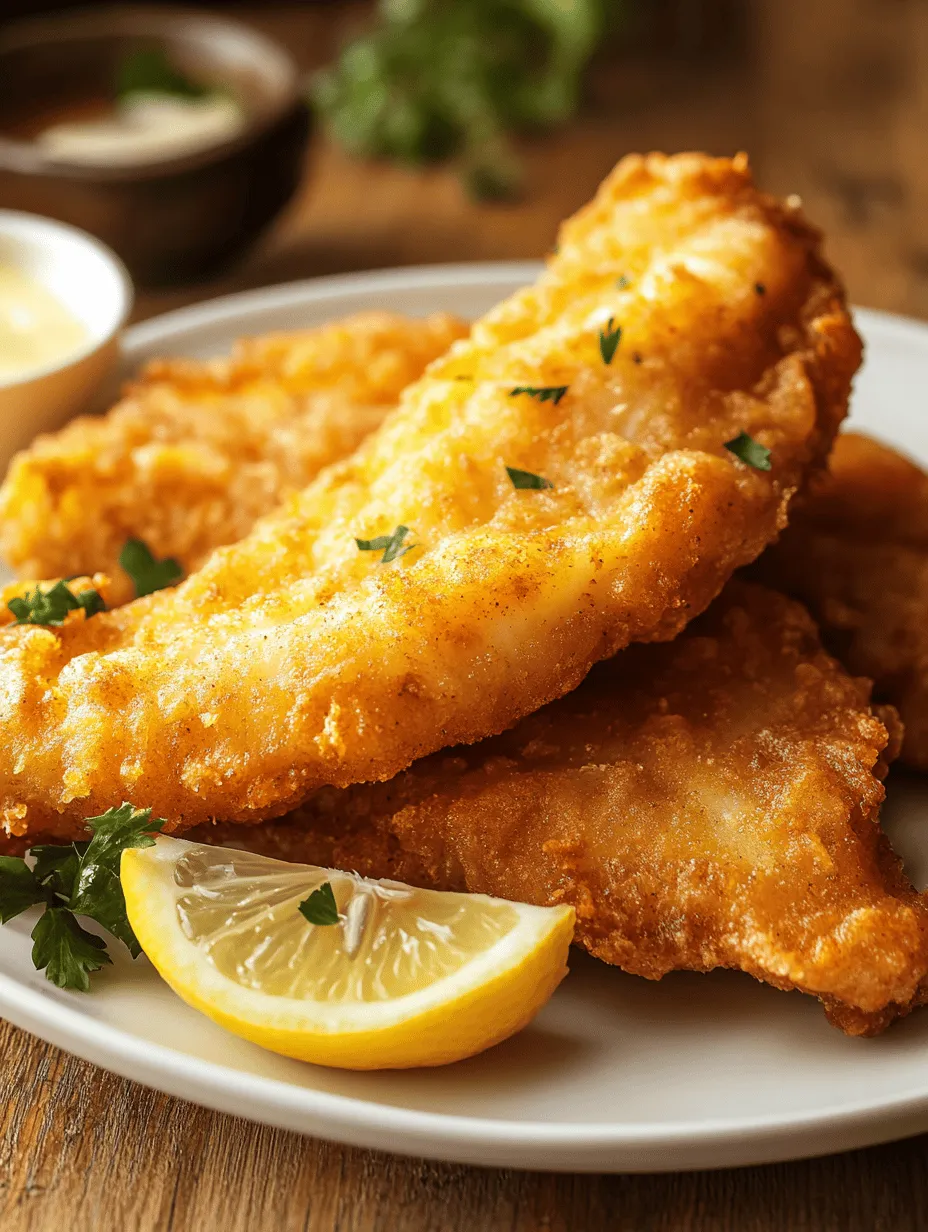Introduction
Battered fish has long held a special place in culinary culture, celebrated for its crispy exterior and tender, flaky interior. It’s a dish that transcends borders, with variations existing in cultures around the world from British fish and chips to Japanese tempura. Among the many beloved versions, Long John Silver’s has carved out a niche, becoming a staple for seafood lovers who appreciate the joy of perfectly fried fish. If you’re a fan of Long John Silver’s, you know how satisfying it is to indulge in their crispy, flavorful fish. But what if you could recreate that beloved experience right in your own kitchen?
This recipe, “Captain’s Catch: The Ultimate Long John Silver’s Fish Batter Recipe,” brings the essence of this iconic fast-food dish into your home. With just a few simple ingredients and some preparation, you can enjoy the delectable crunch of battered fish that’s reminiscent of your favorite seafood chain. Perfect for family dinners, casual gatherings, or simply satisfying your seafood cravings, this recipe offers an opportunity to bond over cooking and share delightful meals with loved ones.
In this article, we’ll walk you through the ingredients that make this batter special, the preparation steps needed to ensure success, and tips for frying the fish to perfection. By the end, you’ll be equipped with the know-how to serve up a plate of golden-brown goodness that rivals any restaurant dish.
Understanding the Ingredients
To achieve that perfect Long John Silver’s-style batter, it’s essential to understand the role each ingredient plays in the recipe. Here’s a comprehensive breakdown:
All-Purpose Flour
The foundation of any good batter starts with all-purpose flour. This versatile ingredient provides the necessary structure to the batter, ensuring it adheres well to the fish during frying. The gluten in the flour helps create a light and airy texture, which is crucial for achieving that signature crispiness. When mixed with the other ingredients, it forms a cohesive batter that envelops the fish, creating a delightful crunch.
Cornmeal
Cornmeal adds an extra layer of flavor and crunch to the batter. Its coarser texture contrasts beautifully with the smoothness of the flour, contributing to a satisfying bite. Additionally, cornmeal lends a subtle sweetness that complements the natural flavors of the fish. This ingredient not only enhances the taste but also elevates the visual appeal with its golden hue once fried.
Baking Powder
Baking powder is the secret to achieving that light and fluffy texture in your batter. When heated, baking powder releases carbon dioxide, causing the batter to expand and become airy. This leavening agent is vital for ensuring that the batter doesn’t become heavy or dense, resulting in a perfect balance of crispiness and tenderness. Including baking powder in your batter is essential for replicating the restaurant-style experience at home.
Salt and Spices
Seasoning is key to enhancing the overall flavor of your batter. Salt not only elevates the taste of the fish but also helps to bring out the flavors of the other ingredients. You can customize your batter by incorporating spices that resonate with your palate, such as paprika, garlic powder, or cayenne pepper. These additions can introduce a delightful kick or a layer of complexity that makes your batter unique.
Cold Water or Beer
The choice between cold water and beer is one of the most debated aspects of making fish batter. Using cold water results in a batter that is lighter and less flavorful, while using beer introduces a richer taste and enhances the texture. The carbonation in beer also helps to create a lighter batter by incorporating air during mixing. Whichever option you choose, make sure it’s cold to ensure a crisp finish when frying.
Oil
Choosing the right oil for frying is crucial for achieving that ideal crispy texture. Oils with high smoke points, such as canola, peanut, or vegetable oil, are optimal for deep frying. These oils can withstand high temperatures without burning, allowing your batter to cook evenly and develop that coveted golden-brown color. Proper oil temperature is vital; too low, and the batter will absorb excess oil, becoming greasy; too high, and it risks burning before the fish is cooked through.
Preparation Steps Explained
With a solid understanding of the ingredients, it’s time to dive into the preparation process. Each step is essential to ensure a successful batter that clings beautifully to the fish and fries to perfection.
Whisking Ingredients
Start by combining your dry ingredients in a mixing bowl. This includes the all-purpose flour, cornmeal, baking powder, salt, and any spices you’ve chosen. Whisking these ingredients together thoroughly is critical to avoid lumps in your batter. A lump-free batter will coat the fish more evenly and create a smooth texture when fried. Gradually add in your cold water or beer, whisking continuously until you achieve a smooth consistency. Aim for a batter that is thick enough to cling to the fish but not so thick that it feels heavy.
The Role of Letting the Batter Rest
After mixing, let your batter rest for about 15 to 30 minutes. This resting period allows the flour to fully hydrate and the gluten to relax, which improves the texture of the batter. Additionally, it helps the batter adhere better to the fish during frying, creating that satisfying crunch. While the batter rests, you can prepare your fish fillets by patting them dry, removing excess moisture that could interfere with the batter’s adherence.
Temperature Control
Temperature control is one of the most crucial aspects of frying. Before you begin frying, prepare your frying equipment. Fill a deep pot or fryer with oil, ensuring it is deep enough to submerge the fish completely. Heat the oil to around 350°F (175°C). To test if the oil is ready, you can drop a small amount of batter into the oil; if it sizzles and rises to the surface, you’re good to go. Maintaining the right temperature is vital for achieving that perfect crispy exterior while ensuring the fish cooks through evenly.
Frying the Fish to Perfection
Now that you have your batter ready and your oil heated, it’s time to fry. Carefully dip each fish fillet into the batter, ensuring it is fully coated. Allow any excess batter to drip off before gently placing the fillet into the hot oil. Fry in batches, making sure not to overcrowd the pot, as this can lower the oil temperature and result in soggy fish. Cook each fillet for about 4-6 minutes, turning occasionally until they are golden brown and cooked through.
Using a slotted spoon, remove the fish from the oil and place it on a paper towel-lined plate to absorb any excess oil. This step is essential for maintaining the integrity of the crispy batter.
By following these preparation steps, you’ll set yourself up for success in creating a homemade version of Long John Silver’s iconic battered fish. Whether served with fries, coleslaw, or tartar sauce, your Captain’s Catch will surely impress!

Best Practices for Dipping Fish Fillets into the Batter
Achieving a perfect coating on your fish fillets is essential for that classic Long John Silver’s experience. Here are some best practices for dipping your fish into the batter:
1. Prepping the Fish: Start with fresh fish fillets, ideally cod, haddock, or any white fish of your choice. Ensure they are thawed (if frozen), rinsed, and patted dry with paper towels. Moisture on the surface can prevent the batter from adhering properly.
2. Batter Consistency: The batter should be thick enough to coat the fish without dripping excessively. If it’s too thin, it won’t cling well; if it’s too thick, it may not fry evenly. Aim for a consistency similar to pancake batter. Adjust with flour or liquid as necessary.
3. Dipping Technique: To achieve an even coating, hold the fish fillet by one end and dip it into the batter. Submerge the fillet almost completely but leave one end free to facilitate handling while frying. Gently lift the fish and allow any excess batter to drip off before placing it into the hot oil.
4. Lightly Shake Off Excess: Instead of shaking or tapping the fish, which can cause the batter to come off, allow the excess to drip naturally, ensuring a consistent layer remains.
Techniques for Ensuring Even Frying and Avoiding Overcrowding
Frying fish to crispy perfection involves more than just the right batter; it’s also about technique. Here are tips to ensure even frying:
1. Temperature Control: Maintain the oil at the right frying temperature, ideally between 350°F and 375°F. Use a deep-fry thermometer to monitor the temperature accurately. If the oil is too cold, the batter will absorb excess oil and become greasy. If too hot, the outside will burn before the inside cooks through.
2. Batch Cooking: Fry the fish in small batches. Overcrowding the frying pot can lower the oil temperature, leading to soggy batter and uneven cooking. A good rule of thumb is to fry no more than two or three pieces at a time, depending on the size of your pot.
3. Turn When Necessary: For even browning, gently turn the fish fillets halfway through the cooking process. This allows both sides to crisp up nicely and ensures they cook evenly.
4. Drain and Rest: Once cooked, remove the fish using a slotted spoon and let it drain on a plate lined with paper towels. This will help absorb excess oil and keep the batter crispy.
Visual Cues for Knowing When the Fish is Done
Knowing when your fish is perfectly cooked is key to a delightful meal. Here are some visual cues to look for:
1. Color: The batter should turn a beautiful golden brown. If it’s pale or light brown, it likely needs more time; if it’s dark brown or burnt, you’ve likely overcooked it.
2. Texture: The batter should appear crisp and crunchy, with a slightly puffed texture. If it appears too soft or wet, it may not have cooked fully.
3. Flakiness: When you cut into the fish, it should flake easily and appear opaque and moist inside. If the flesh is still translucent, it requires more cooking time.
Serving Suggestions
Once your Captain’s Catch fish is ready, it’s time to present the dish beautifully for an enjoyable dining experience. Here are some serving suggestions:
1. Presentation: Serve the battered fish on a large platter or individual plates. Arrange the fillets in a staggered, overlapping fashion for an appealing look. Sprinkle some fresh parsley or dill on top for a pop of color.
2. Complementary Sides: Classic sides to accompany your battered fish include:
– Coleslaw: A crunchy, tangy coleslaw pairs well, providing a refreshing contrast to the hot, crispy fish.
– French Fries: Golden, crispy fries are a traditional pairing. You can also try sweet potato fries for a twist.
– Corn on the Cob: Sweet corn adds a delightful sweetness to balance the savory flavors.
3. Dipping Sauces: Enhance your meal with a variety of dipping sauces:
– Tartar Sauce: A classic choice made with mayonnaise, pickles, and lemon juice.
– Lemon Wedges: Fresh lemon juice drizzled over the fish adds brightness and cuts through the richness.
– Spicy Remoulade: A zesty remoulade brings a kick of flavor, perfect for those who enjoy a bit of heat.
4. Creative Plating Ideas: For an upscale presentation, consider serving the fish on a bed of greens or alongside colorful roasted vegetables. Use parchment paper for a rustic touch, or present it in a basket lined with checkered paper for a casual feel.
Nutritional Information
Understanding the nutritional aspects of your Captain’s Catch recipe is important for making informed meal choices. Here’s an overview:
1. Caloric Content: A typical serving of battered fish (about 4 ounces) can range from 250 to 400 calories, depending on the type of fish and the amount of batter used. The frying process adds additional calories due to oil absorption.
2. Macronutrient Breakdown:
– Protein: Fish is an excellent source of high-quality protein, providing around 20-25 grams per serving.
– Fat: The frying process contributes to the fat content, with estimates of 10-20 grams, mainly from the oil used.
– Carbohydrates: The batter adds approximately 15-25 grams of carbs, depending on the recipe used.
3. Portion Sizes: To keep your meal balanced, consider serving smaller portions of fish alongside generous servings of vegetables or salad. This approach helps maintain a healthy caloric intake while still enjoying the rich flavors of battered fish.
Cultural Significance of Battered Fish
Battered fish has a rich history and cultural significance in many cuisines around the world. Here’s a brief exploration of its origins and adaptations:
1. Origins: The concept of frying fish in batter dates back to the 19th century, with roots often traced to British “fish and chips.” This dish became popular among the working class, providing a filling and affordable meal.
2. Global Adaptations:
– British Fish and Chips: This dish features thick-cut fish, often cod or haddock, fried in a light batter and served with thick-cut fries and malt vinegar.
– Japanese Tempura: In Japan, a similar technique is used to create tempura, where fish and vegetables are coated in a light batter and fried. This dish is usually served with a dipping sauce and rice.
– Latin American Variants: In many Latin American countries, fried fish is often seasoned with spices and served with various salsas or sauces.
3. Evolution of Battered Fish: Over the years, battered fish has evolved with regional tastes, leading to unique interpretations across different cultures. Whether served in a casual seaside shack or a high-end restaurant, this dish remains a beloved staple worldwide.
Conclusion
Making Captain’s Catch at home offers not just a delicious meal but also a joyful experience that can be shared with family and friends. The satisfaction of frying your own fish, achieving that perfect crispy batter, and pairing it with delightful sides and sauces is truly rewarding.
Don’t hesitate to experiment with the recipe, whether by trying different types of fish or adding your unique twist to the batter. The beauty of this dish lies in its versatility, allowing you to create a version that suits your preferences and those of your loved ones.
As you gather around the table to enjoy your homemade battered fish, take a moment to appreciate not just the culinary delight before you but also the shared experience of creating and savoring a beloved dish together. Happy cooking!


